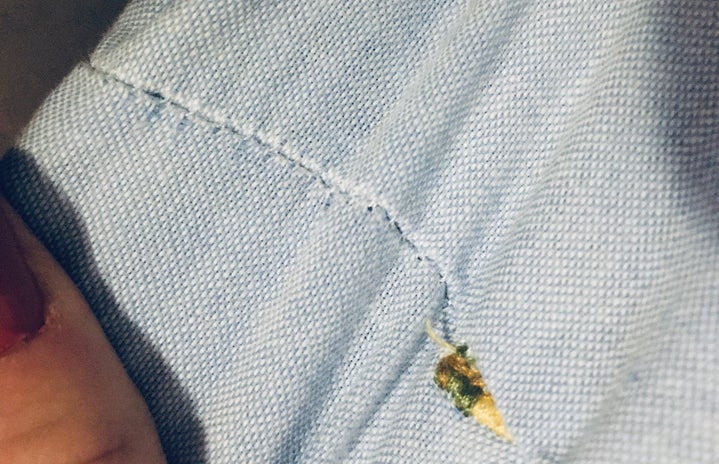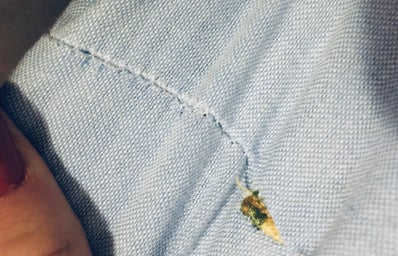In the (edited) words of John Bender, buttons fall off all the time; the world is an imperfect place. A lot of people don’t know how to sew one back on to their clothing. To be fair, not a lot of us were taught this at school, and if we were, it was usually just for the girls. But sewing a button is an invaluable skill, no matter who you are.
The first step is to thread a needle. Pick up a needle and look at it. One end of the needle (not the sharp one) has a small hole in it. This is called the eye of the needle, and your thread has to go through it. This is what lets you pull the thread through any kind of fabric.
Threading a needle can be quite tricky. It’s important that the size of your needle and the thickness of the thread match. You’ll need to strike a balance between the eye being large enough for the thread, and small enough that it moves easily through the fabric. Most boxes of needles have a variety of needle sizes, so try a few different ones until you find one that works for you!
Once you have threaded the needle, you have one of two options –
-
Tie both loose ends together. This will make the actual sewing easier, but will make the thread twice as thick.
-
Tie a small knot into the longer loose end. This is preferable for thread that is already thick. Take care not to let the thread slip out of the eye of the needle!
Either way, the knot helps you anchor your thread when you start sewing.
Now, to the button. To sew one back on, pick a thread colour that matches the one that’s been used for the buttons still on the clothing. If there are no other buttons, pick a colour that matches the fabric itself. If you cannot find the loose button, you’ll need to get one that looks similar to any other buttons on the garment.
There are three common types of buttons. They’re all stitched differently.
-
The first is flat and has two small holes in the centre. Insert the needle through the part of the fabric where you want to stitch this button, and then through one of the holes in the button. Make sure that you insert the needle from the side of the fabric that won’t be seen. Similarly, insert the needle through the reverse side of the button. Once you’ve pulled all the thread through, insert the needle into the remaining hole and then through the fabric. Repeat this a couple times until the button is securely fastened. Tie off the thread by putting the needle through a small section of fabric – a millimetre or so is enough – on the hidden side of the cloth and then going through the loop of thread created. Pull this tight, and cut the excess thread.
-
The second is flat but with four holes in the centre. This one is sewn similar to the first type. Treat holes on opposite corners as pairs, and switch between pairs. In other words, stitch through two diagonal holes as you would if these were the only two, then through the other two diagonal holes. Repeat this a few times until the button is secure, then tie off and cut the thread.
-
The third has a small loop of plastic (or whatever material the button is made of) on the underside of the button. To sew this type of button, pull the needle through the back of the part of fabric where you want to stitch the button, and then into the loop on the button. Then insert the needle back into the fabric. Repeat until the button is secure, then tie off and cut the thread.
And there you have it! You should now be able to stitch most buttons. If you find a weird one that doesn’t fit these three types, remember that the process is more or less the same. Go through the fabric from the reverse side, go through the button in any way you can, come back to the fabric and repeat. Happy sewing!



